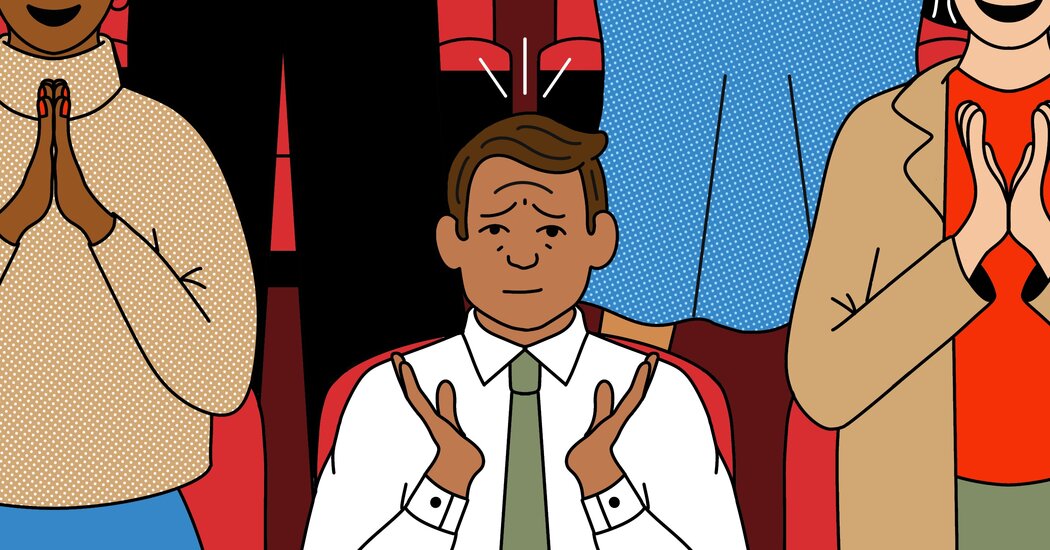Do you have a question for our culture writers and editors? Ask us here.
Q: Are standing ovations expected now? It seems like every show or concert I’ve seen lately has ended with one.
First things first: You’re not imagining things. Standing ovations have become ubiquitous in recent years. They’re now so frequent that it often feels to me as if the audience members making a statement are those who choose to remain seated, rather than those who rise to their feet.
How common is this?
Standing ovations are nearly universal on Broadway, but a little more variable Off Broadway — more common for musicals than plays, more common for upbeat shows than those that end in emotional darkness, more common for those with younger audiences, who tend to be more demonstrative (and sometimes more spry).
The pattern seems to be similar in the classical music world. Zachary Woolfe, our classical music critic, tells me that standing ovations are now de rigueur at opera and symphony performances in the United States, but less so in Europe.
In other areas of the performing arts, ovations aren’t quite as frequent. Gia Kourlas, our dance critic, says it is rarer to see a whole crowd rise after a dance performance — although it does happen at particularly thrilling shows. Jason Zinoman, our comedy critic, says he doesn’t see ovations at comedy clubs, but that big-name comedians will get ovations when performing in theaters.
Why is it happening?
The act of applauding to signal approval goes way back. It’s not clear when standing ovations began, but they seemed to become more popular in the mid-20th century as a way of acknowledging remarkable performances, and they have become a more routine way of acknowledging performers at the end of a show.
In 1950, when Howard Taubman reported for The New York Times on an Arturo Toscanini-conducted NBC Symphony Orchestra concert in Pasadena, Calif., the standing ovation was headline-worthy.
But over the years, the phenomenon ceased being exceptional; in 2003, The Times published “The Tyranny of the Standing Ovation,” noting how even flops were getting ovations, and in 2012 the critic Ben Brantley penned a Times essay calling for a return of the “sitting ovation,” saying “we really have reached the point at which a standing ovation doesn’t mean a thing.”
“Over the years it has become more and more pervasive,” said Robert Viagas, the author of “Right This Way: A History of the Audience,” “to the point where, on those rare instances when a performance doesn’t get a standing ovation, you can see it on the actors’ faces, like ‘What did we do wrong?’”
There’s also peer pressure. “It appears that it’s just about being polite,” said the Tony-winning actress Stephanie J. Block. She made her West End debut this year, starring in a revival of “Kiss Me, Kate,” and noticed that in London “the culture is quite different — you have to earn it.”
Many people cite economics as a contributing factor — patrons spend a lot of money to see Broadway shows, and ovations are a way of publicly signaling what a great night they had. “People feel they are justifying the price of the ticket they paid,” Viagas said.
And then there is a practical concern: Once people in front of you start standing, you can’t see the curtain call unless you stand, too.
Is it really so bad?
Traditionalists often wring their hands about the mainstreaming of standing ovations, which they believe has lessened the meaning of the gesture.
“If I don’t stand at the end of a Broadway show, people look at me like I’m an aberrant personality,” said Laurence Maslon, an arts professor at New York University’s Tisch School of the Arts. “It’s taken all the fun out of acknowledging something that’s life-changing.”
But Viagas says that ovations can be pleasurable for patrons.
“People like to applaud,” he said. “This is your moment to give back. It’s not a movie — the actors are actually there — and this is a way of speaking to the actors and the creators to say, ‘You did a good job, and I appreciate that, and thank you.’”
So what should I do?
You don’t have to stand up. There are always holdouts — some people have physical conditions that make standing more challenging, and some stick to the now old-fashioned idea that ovations should be reserved for exceptional performances — and you can be one of them.
“It’s not a rule that one must stand at the end of a show,” said Ben West, the author of The Musical Theater Report, an online journal.
But, also, even if you feel compelled to join the standers, you have options. There are, Viagas says, ways to clap that range from the merely courteous (tapping fingers to fingers) to the jubilant (cupping hands to create more noise, lifting hands to be more visible). And then there is what he calls “the walking ovation,” which is clapping while trying to beat everyone else to the door, and “hate-applause,” which is clapping really slowly.
The choice is yours.

